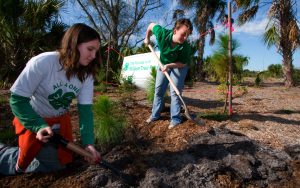Homeowners, business owners and others can plant the right tree in the right place in cities and suburbs with help from a newly relaunched website from University of Florida scientists.
If “right tree, right place” sounds similar to the Florida-Friendly Landscaping™ principal of “right plant, right place,” it’s no coincidence.
“By planting species that are more suitable for a particular site, tree benefits can be maximized, management inputs can be reduced, and potential risks may be avoided,” said Ryan Klein, a UF/IFAS assistant professor of environmental horticulture. “Additionally, such trees may fare better during extreme weather events brought on by climate change.”

With the Atlantic Hurricane Season starting June 1, information on the Florida Trees website might mean the difference between a tree surviving a tropical storm or hurricane.
“Using the information provided on the site has the potential to improve the long-term survival rate of tree plantings in the urban landscape,” Klein said. “Providing trees adequate space for future growth above ground and below ground can improve things such as stability, canopy cover, resilience to stressors, etc.”
Previous UF/IFAS research on 150 urban tree species looked into what makes a tree more resistant to wind. In hurricanes Ivan and Jean (2004), scientists found that trees that grow in groups survive slightly better than those grown alone.
Tree survival depends on air and moisture in the soil. If these factors are managed correctly, trees will grow quickly after they’re planted. Some of the most common causes of tree death are planting too deep, not watering enough or watering too much.
Klein talked briefly about the website at last month’s UF/IFAS Urban Landscape Summit.
The website is a resource for homeowners, business owners and government officials.
“Essentially each group has the potential to benefit in the same way — maximize tree benefits and minimize management inputs,” Klein said. “They can also help establish trees and promote long-term success in the landscape.”
The website is a collaboration of Klein and Howard Beck, a UF/IFAS professor emeritus in agricultural and biological engineering. It was funded by the Florida Chapter of the Society of Arboriculture.
###
ABOUT UF/IFAS
The mission of the University of Florida Institute of Food and Agricultural Sciences (UF/IFAS) is to develop knowledge relevant to agricultural, human and natural resources and to make that knowledge available to sustain and enhance the quality of human life. With more than a dozen research facilities, 67 county Extension offices, and award-winning students and faculty in the UF College of Agricultural and Life Sciences, UF/IFAS brings science-based solutions to the state’s agricultural and natural resources industries, and all Florida residents.
 5
5
